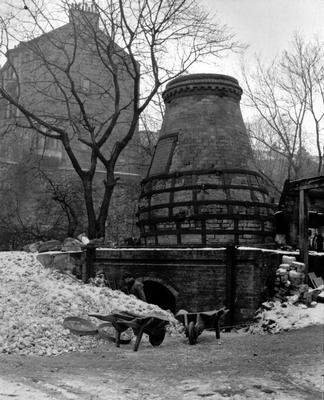
The old flint mill on the Kelvin, 1955.
On the left is a large pile of flint nodules, probably imported from England or France. The nodules were burned in the kiln shown here until they were calcinated (that is had turned white and become friable). By 1955 only this part of the flint mill was in operation.
In earlier years, however (according to the Glasgow journalist James Cowan, aka "Peter Prowler"), the calcinated flint nodules were then put into grinding tubs with water and ground for about eight hours to a thick creamy fluid. The fluid was pumped across the yard to two vats in a drying shed, the surplus water drained off the paste heated for about 24 hours until it was thick enough to be cut into blocks. The blocks were sold to the potteries in Paisley, who used the material in the manufacture of glaze for tiles and crockery. The mill closed down in the early 1960s and in 1964 the grinding mill and drying shed were demolished. The ruins of the kiln, the weir and the lade survive in 2004, having been preserved as features of the Kelvin Walkway.
In 1955 Partick Camera Club set out to create a photographic survey of Glasgow. As the project progressed, other camera clubs joined and each was allocated a district of the city to photograph. Glasgow Museums exhibited the photographs at Kelvingrove Art Gallery and Museum and at the People's Place, and in 1956 the exhibition was shown at the Palace of Art in Bellahouston Park. The photographs are now part of Glasgow Museums' collections.
Reference: 1005.97.87 / OG.1955.121.[89]
Reproduced with the permission of the Partick Camera Club
Keywords:
flint mills, flint nodules, Glasgow Photographic Survey 1955, Kelvin Walkway, kilns, North Woodside Flint Mill, pottery glazes, sieves, tenements, wheelbarrows
You have 1 image in your photo album.